The beautiful and impressive anacondas and boas of Brazil
Boas and anacondas belong to the Boidae family, a group of very ancient snakes that have existed since the Paleocene Era. They differ from modern snakes in that they have vestigial bones from what were their hind legs thousands of years ago.
These snakes are found on every continent except Antarctica. They are known to be medium to large in size and can grow to over 20 feet in length, especially the females as they are larger than the males. They are solitary, nocturnal snakes with large slit pupil eyes that help them control the amount of light reaching their retinas.
They feed mainly on rodents and all have aglyph teeth so they are not venomous, although they can bite. Boas and anacondas grab their prey with their mouths, but they kill by constriction; this means that once an animal is caught, the snake wraps its body around it several times and squeezes until it suffocates — often without breaking a single bone.1
Contrary to popular belief, these snakes do not crush all the bones of their prey to death, but rather stop it from breathing. The prey is swallowed whole and can take days or even weeks to digest, and only after this long period will they feed again.1
Boas and anacondas are divided into 14 genera and 66 species, of which 4 genera and 12 species can be found in Brazil: 2
Anacondas (Eunectes)
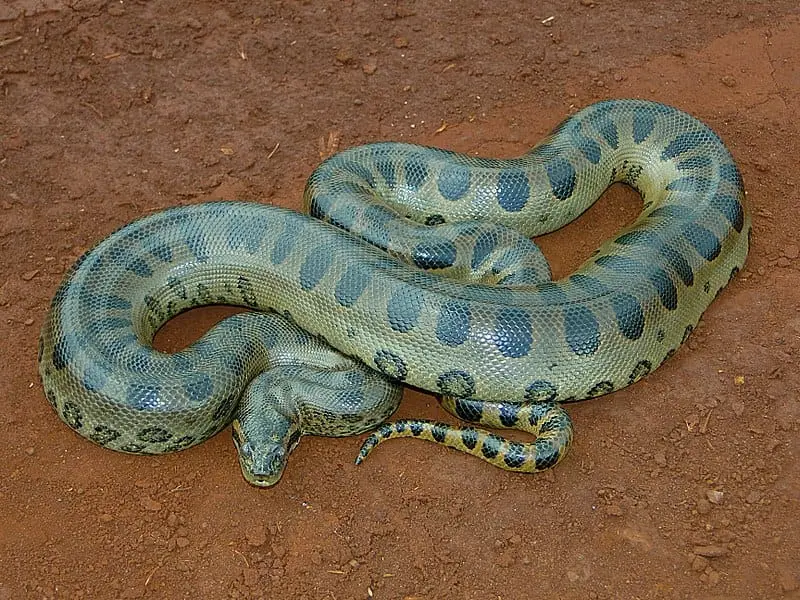
Anacondas are not only one of the oldest snakes in the boid family, but also one of the largest. They can grow from 2 to 9 meters (6 to 30 feet) long, depending on the species, but are generally around 4.5 meters (15 feet) long.
Anacondas are heavy and slow snakes on land, so they spend most of their time underwater, where they are more agile and can catch the fish, amphibians, and water birds they feed on. Larger individuals may also feed on alligators, capybaras, peccaries, and even deer1.
Although there are many stories of anacondas swallowing people, anacondas are shy snakes and avoid contact with humans. Its first reaction to humans is to move away, and if it still feels threatened, it may strike to keep the threat away.
An anaconda will only swallow a human if the victim is a child and the snake is larger than scientifically confirmed size estimates (over 9 m), in addition, humans are not part of its natural diet. Because of its habits, an anaconda would only attempt to swallow a human if there was no natural prey left in its habitat and the animal was very hungry.3 In fact, many more people kill anacondas than anacondas kill people.
There are four species of anaconda, three of which are found in Brazil:
Dark-spotted anaconda (E. deschauenseei): It is the smallest species of the genus, reaching up to 3 m (10 ft) in length and 60 kg (220 lb) in weight. It occurs only in eastern Pará and in French Guiana.4
Yellow anaconda (E. notaeus): It has a length of 2.4 to 4.6 meters (8 to 15 feet). It inhabits the Brazilian pantanal.1
Green anaconda (E. murinus): It is one of the largest and most famous snakes in existence, rivaled only by the reticulated python (P. reticulatus) is found in Southeast Asia. It can reach up to 9 m (30 ft), but most individuals are around 4.5 m (15 ft) 5. It is found in almost all of Brazil, not just the Pampas and part of the Atlantic Forest 6.
Red-tailed boa, (Boa constrictor)
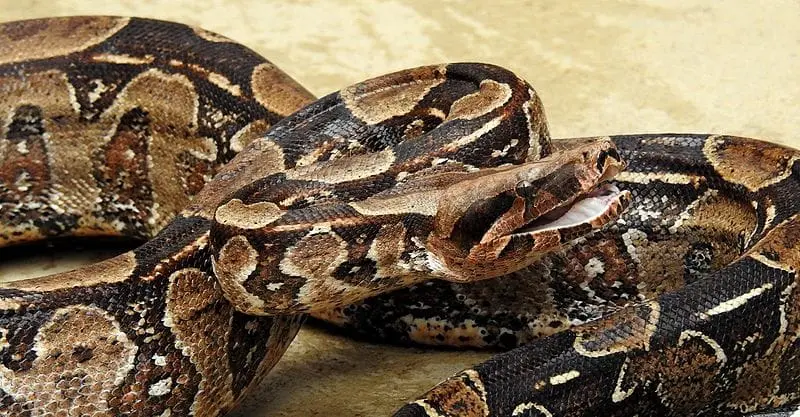
There are five species of boa constrictors found from Mexico to Argentina, but only the B. Constrictor is found in Brazil — it occurs throughout the country with the exception of the southern region 7.
Boa constrictors are semi-arboreal snakes - especially when young, they are also excellent swimmers and can be found in aquatic environments 8. They grow up to 4 m (13 ft) long and can weigh more than 10 kg (22 lb). They feed primarily on small mammals such as marsupials and rodents, as well as birds and lizards.
Rainbow boas (Epicrates)
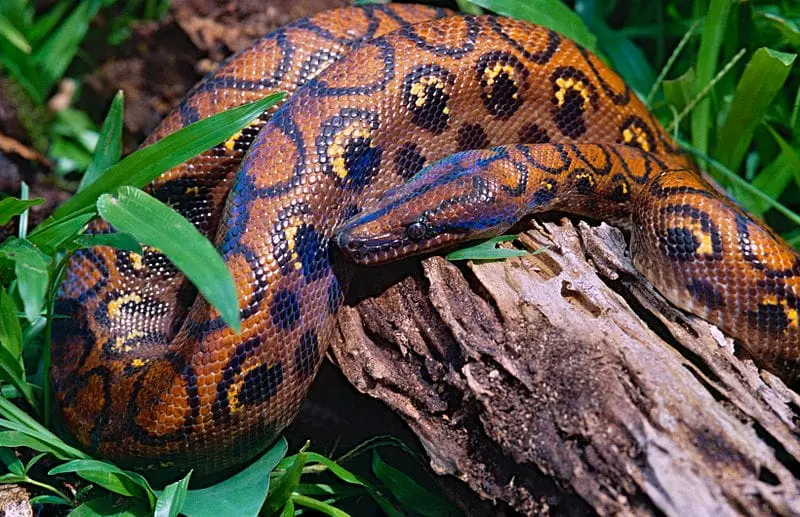
Rainbow boas are arboreal when young, but become semi-arboreal as they mature. Although they avoid water, they are good swimmers.
They feed on small mammals, but may supplement their diet with birds. Because of the attractive iridescent sheen of their scales, they are often hunted for their skin or by animal traffickers.9
There are five species of rainbow boas, four of which are found in Brazil:
Caatinga rainbow boa(E. assisi): is endemic to the Caatinga. It reaches about 2 meters (6.5 feet) in length.
Rainbow boa (E. cenchria): It is the best known species. It is found throughout the Amazon rainforest and in the Northeast Atlantic forest. It reaches an average length of 1.7 meters (5.7 feet), but can reach up to 2 meters (6.6 feet).
Paraguayan rainbow boa (E. crassus): It inhabits the central region of South America. In Brazil, it can be found from southern Amazonas to northern Paraná and eastern Bahia. Its maximum size is 1.20 m (4 ft), and it is the smallest species.
Brown rainbow boa (E. maurus): Also known as Colombia rainbow boa. It occurs from Panama to the north of the Brazilian Amazon rainforest. It can reach up to 2 m (6 ft) in length.10
Corallus
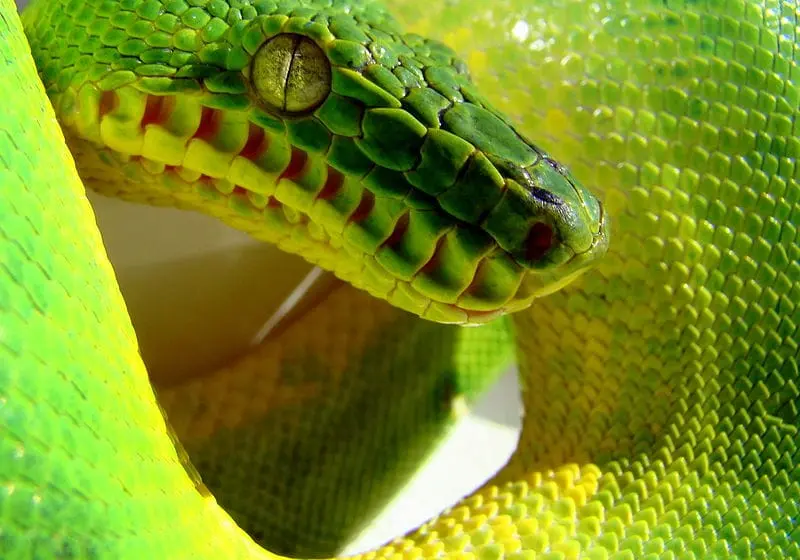
Snakes of this genus are mainly arboreal and rarely descend to the ground. These snakes have deep thermoreceptor fossae near their lips that allow them to detect small thermal variations in the environment and find their prey more easily.
They are found in Central America and most of South America except for Paraguay, Argentina, and southern Brazil. Of the nine species, four are found in Brazil.11
Amazon tree boa (C. hortulana): The Amazon Tree Boa has the largest distribution of all snakes in its family (Corallus), occurring in almost all of South America — in Brazil only it is not found in the south. It is 1.5 to 2 meters (4 to 6 feet) long.12
Cropani’s tree boa (C. cropanii): It is the most enigmatic member of the genus due to its rarity. Fewer than ten individuals have been found since its description nearly 60 years ago. 2 13 One of the most recent sightings was in 2017, when researchers found the first live Cropani’s tree boa in the municipality of Sete Barras/SP.
The specimen, which measured 1.70 m (5.5 ft), was fitted with a tracker and released into the wild. The tracker will provide researchers with new information about the animal’s lifestyle and habits — vital information for the conservation of this endangered species. 14 13
C. batesii e C. caninus
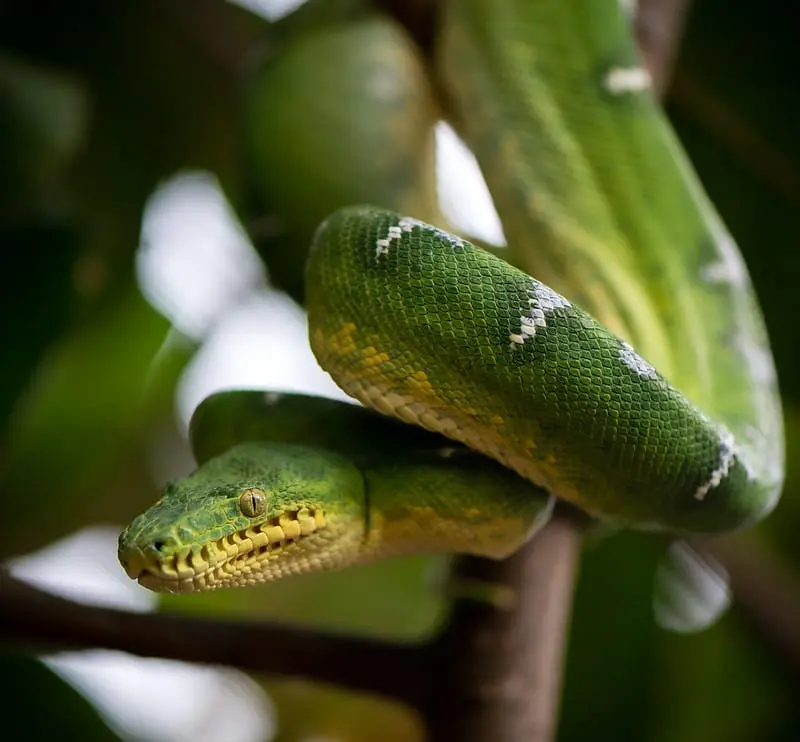
These two species were considered the same until 2009, so they are known by the least popular names: Emerald Tree Boas.
These snakes are very difficult to find because they live in the canopy of the trees. Only when they are hunting can they be seen close to the ground looking for prey. It was once thought that their diet consisted mainly of birds. However, the results of studies indicate that a large part of their diet consists of small mammals, such as marsupials and rodents15 16.
They have proportionally the largest teeth of all snakes, and because of this, their vertical pupils and triangular heads, they can be mistaken for venomous snakes. However, these large teeth are only used to grab and swallow their prey.
Amazon Basin emerald tree boa(C. batesii): Adult individuals are green with white patterns all over the dorsal region. It differs from C. caninus by sometimes having an additional white band along the spine and black dots outlining the white patterns, and the scales on the snout are small. It is found south of the Amazon River and west of the Negro River.
Emerald tree boa (C. caninus): Adult individuals are green with white patterns all over the dorsal region. It differs from C. batesii by the adults of this species are sometimes completely green, and the scales on its snout are large. It is found north of the Amazon River and east of the Negro River. 17 2 18
The Morelia viridis of New Guinea and C. caninus are often mistaken, being good examples of convergent evolution.15
Conservation
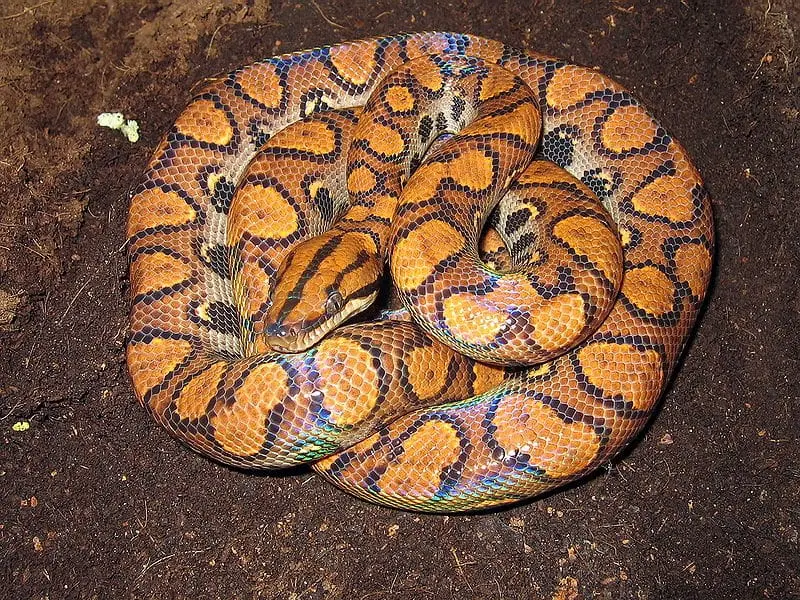
According to the IUCN (International Union for Conservation of Nature) and ICMBio, none of the Brazilian boas and anacondas are threatened with extinction, as they usually have a wide distribution and some species live in protected areas. Only the Cropani’s tree boa is considered “vulnerable” by ICMBio and “endangered” by IUCN due to its small range and rare sightings — it is estimated that there are less than a thousand individuals.
Some species, such as boa constrictors, rainbow boas and emerald tree boas, are often captured by animal traffickers to be sold as pets. For people living near these animals, ignorance, fear, and local culture lead to the killing of these snakes for prevention, for their meat, skin, or even for traditional medicine. In addition, increasing deforestation in many of the regions where boas and anacondas live may threaten them in the not too distant future.
Although they are currently abundant, constant education is needed so that the general population understands the importance of these animals in nature and the importance of preserving their habitat.
Read more at:
-
R. Graham Reynolds, Robert W. Henderson. Bulletin of the Museum of Comparative Zoology, 162(1):1-58 (2018)https://doi.org/10.3099/MCZ48.1 ↩︎
-
Emmer R. The Giant Anaconda and Other Cryptids: Fact or Fiction? New York: Chelsea House; 2010.http://site.ebrary.com/id/10403552 . Accessed January 12 2023. ↩︎
-
Texas SchoolarWorks - Catalogue of American Amphibians and Reptiles - Eunectes deschauenseei ↩︎
-
DNA Barcode 101 - Investigating the evolutionary relationships of species within the Boa constrictor species complex ↩︎
-
The Online Guide to the Animals of Trinidad and Tobago - Epicrates maurus (Rainbow Boa or Velvet Mapepire) ↩︎
-
SALAMANDRA - German Journal of Herpetology - New record of Corallus cropanii (Boidae, Boinae): a rare snake from the Vale do Ribeira, State of São Paulo, Brazil ↩︎
-
UOL - Cobra raríssima, só vista 3 vezes no Brasil, é resgatada de cativeiro em SP ↩︎
-
Henderson, R.W., Pauers, M.J. and Colston, T.J. (2013), Morphology, Trophic Ecology, and Phylogeny in Treeboas. Biol J Linn Soc Lond, 109: 466-475. https://doi.org/10.1111/bij.12052 ↩︎
-
Youtube - Biólogo Paulo Bernarde - Listas de Serpentes do Planeta e do Brasil ↩︎
-
Henderson, Robert & Passos, Paulo & Feitosa, Darlan. (2009). Geographic Variation in the Emerald Treeboa, Corallus caninus (Squamata: Boidae). Copeia. 2009. 10.1643/CH-08-190 ↩︎
